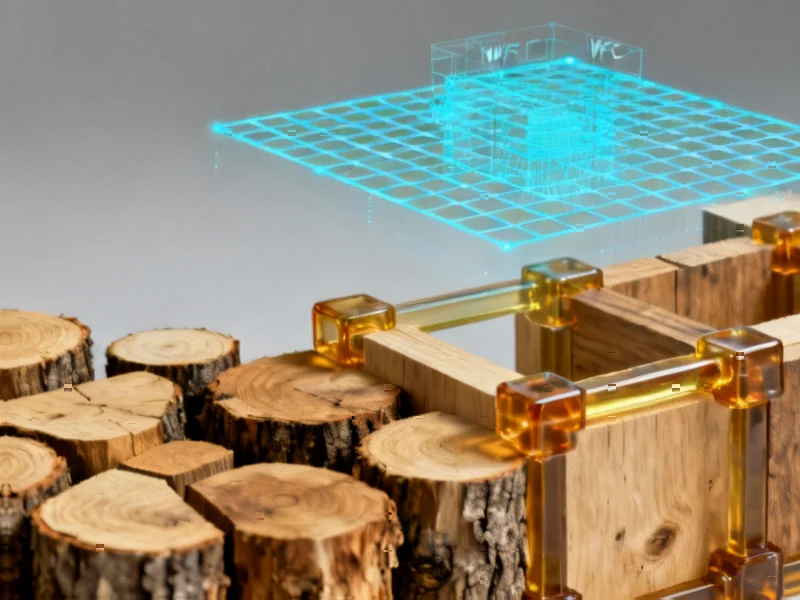The Untapped Potential of Irregular Wood in Construction
In the realm of sustainable architecture, conventional timber elements have dominated construction while irregular wood components—including unprocessed logs, forks, and branches—remain largely overlooked. These natural forms, with their complex geometries, present significant challenges for traditional building methods, leading to substantial material waste in an industry that desperately needs sustainable solutions. The innovative integration of computational design, augmented reality, and advanced joinery techniques is now unlocking unprecedented opportunities for circular design in construction.
Table of Contents
- The Untapped Potential of Irregular Wood in Construction
- Digital Transformation Through Wave Function Collapse
- Innovative Joinery Solutions Using Recycled Materials
- Augmented and Mixed Reality in Assembly Processes
- Circular Economy Integration in Construction
- Practical Applications and Scalable Solutions
- Future Directions and Industry Impact
Digital Transformation Through Wave Function Collapse
At the forefront of this revolution is Wave Function Collapse (WFC), a computational method that enables automated spatial configuration of irregular wood elements. This groundbreaking approach begins with comprehensive 3D scanning of each unique wood piece, capturing its distinctive geometry and structural characteristics. The WFC algorithm then processes this data to generate optimal arrangements that maximize material utilization while maintaining structural integrity.
The process integrates finite element analysis (FEA) to assess structural viability before physical assembly, ensuring that each configuration meets necessary safety standards. This digital workflow represents a significant advancement in Computer-Aided Architectural Design (CAAD), allowing designers to work with nature’s imperfections rather than against them. By embracing the inherent variability of natural wood forms, this method transforms what was once considered waste into valuable building components.
Innovative Joinery Solutions Using Recycled Materials
Complementing the digital design process is a revolutionary joinery method that utilizes recycled PET bottles to create structurally stable connections. This heat-moldable technique leverages the thermal properties of PET plastic, which shrinks when heated, creating tight, secure bonds between wood components without requiring adhesives or mechanical fasteners., according to technology insights
The environmental benefits of this approach are substantial. Not only does it eliminate the need for traditional joining materials that often contain harmful chemicals, but it also provides a practical application for plastic waste that might otherwise end up in landfills or oceans. The method demonstrates how multiple waste streams can be simultaneously addressed through thoughtful design and engineering., according to industry analysis
Augmented and Mixed Reality in Assembly Processes
The implementation of Augmented Reality (AR) and Mixed Reality (MR) technologies has transformed the assembly phase of upcycled wood projects. These tools provide real-time visual guidance during construction, overlaying digital models onto physical workspaces to ensure precise component placement. This technology is particularly valuable when working with irregular wood elements, where traditional measurement and alignment techniques often fall short.
Through AR-assisted assembly, even unskilled workers can quickly master complex construction techniques, significantly reducing the learning curve associated with unconventional building methods. The technology provides step-by-step visual instructions, identifies potential conflicts before they occur, and ensures that each component is positioned according to the digital design specifications.
Circular Economy Integration in Construction
The broader context of this research aligns with circular economy principles that emphasize:
- Transforming waste materials into higher-value products
- Reducing reliance on virgin resources
- Creating closed-loop material cycles
- Minimizing construction and demolition waste
Traditional construction practices generate enormous amounts of waste, with wood representing a significant portion of construction and demolition debris. The proposed framework addresses this challenge by creating systems where wood components can be repeatedly disassembled and reconfigured into new structures, effectively resetting the material lifecycle.
Practical Applications and Scalable Solutions
The research has been validated through the creation of functional furniture and pavilion-scale architectural prototypes. These demonstrations showcase how digital technologies enable the transformation of irregular wood into:
- Structural architectural elements
- Functional furniture pieces
- Public installation artworks
- Temporary pavilion structures
Each application demonstrates the scalability of the approach, from small-scale furniture items to larger architectural interventions. The methods developed through this research provide a roadmap for integrating circular wood reuse into urban environments at various scales, offering practical solutions for architects, designers, and builders seeking sustainable alternatives to conventional construction materials.
Future Directions and Industry Impact
The integration of these technologies represents a paradigm shift in how we approach material use in construction. As the methodology continues to evolve, several key areas show particular promise for further development:, as our earlier report
Robotic fabrication systems could automate the processing of irregular wood elements, increasing efficiency and precision while reducing labor requirements. Advanced material databases could catalog the properties of available wood components, creating digital inventories that designers can access when planning new projects. Machine learning algorithms could optimize the matching of wood forms to specific architectural applications, further enhancing material utilization rates.
This research demonstrates that sustainable construction doesn’t require compromising on design quality or structural performance. By leveraging digital technologies and innovative material strategies, we can create buildings and objects that are not only environmentally responsible but also aesthetically compelling and structurally sound. The future of sustainable architecture lies in our ability to work intelligently with the materials nature provides, transforming what was once considered waste into valuable resources for the built environment.
Related Articles You May Find Interesting
- Coldriver’s Evolving Arsenal: Inside Russia’s Latest “NoRobot” Cyber Espionage C
- New AI Model Overcomes Data Bias to Revolutionize Drug Discovery Predictions
- Asgard Archaea’s DNA Replication Secrets Rewrite the Story of Eukaryotic Evoluti
- WatchGuard Fireware OS Vulnerability Puts 71,000+ Devices at Risk of Remote Take
- Advanced Machine Learning Outperforms Traditional Diagnosis for Alpha Thalassemi
This article aggregates information from publicly available sources. All trademarks and copyrights belong to their respective owners.
Note: Featured image is for illustrative purposes only and does not represent any specific product, service, or entity mentioned in this article.



